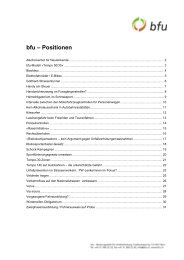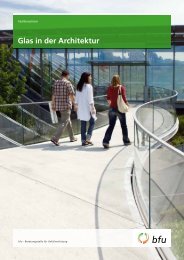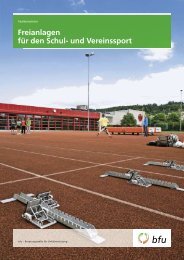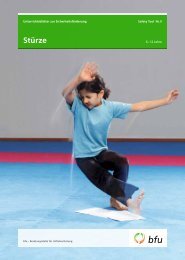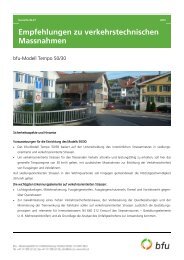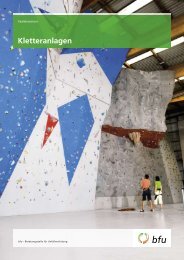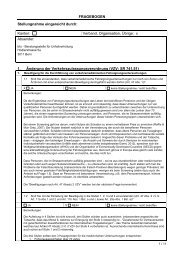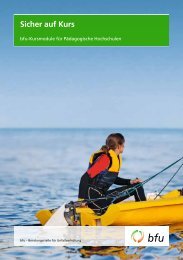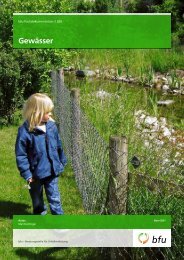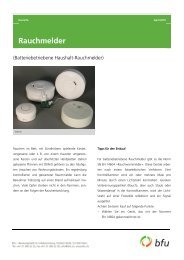Haus und Freizeit - bfu
Haus und Freizeit - bfu
Haus und Freizeit - bfu
Erfolgreiche ePaper selbst erstellen
Machen Sie aus Ihren PDF Publikationen ein blätterbares Flipbook mit unserer einzigartigen Google optimierten e-Paper Software.
Senior citizens not living independently can be<br />
subdivided into three (setting-specific) categories<br />
(Table 6):<br />
• Senior citizens still living in their own homes,<br />
but with outside care<br />
• Senior citizens living either temporarily or permanently<br />
in nursing homes<br />
• Senior citizens living as patients in hospitals<br />
In general, the prevention opportunities that have<br />
been described in connection with «persons living<br />
independently» are also relevant with reference to<br />
senior citizens «not living independently». While, in<br />
the case of the latter, the training of the «basic<br />
motor skills» is also considered preferable, this<br />
form of intervention does not play a central role for<br />
the prevention portfolio. Here, prominence should<br />
be given to the promotion of activities of daily<br />
living to maintain muscle mass, balance as well as<br />
strength and mobility from the point of view of<br />
injury prevention. Developing a daily routine into<br />
which exercise is integrated is also recommended.<br />
Where responsibility for prevention is concerned, a<br />
«setting-specific shift» can generally be noted.<br />
Responsibility for prevention (in the sense of active<br />
versus passive participation on the part of the senior<br />
citizens concerned) is shifting from a more active<br />
participation within the «living independently»<br />
setting to a more passive participation within the,<br />
«hospital» setting. This also corresponds to a shift<br />
from more behaviorally oriented to situationally<br />
oriented prevention options. This is why the role of<br />
nurses and carers is gaining in importance. Prevention<br />
options that are listed in connection with «private<br />
infrastructure» relate to nursing homes or<br />
hospitals, for example. Depending on the supporting<br />
institution, these prevention options can also<br />
equally be assigned to the «public infrastructure».<br />
Table 6<br />
Highly recommended <strong>und</strong> recommended prevention possibilities: Falls – senior citizens not living independently<br />
Risk factor Prevention option Assessment<br />
Socio-demographic factors<br />
Post-fall syndrome (fear of Screening (screening/assessment tools)<br />
Recommended<br />
falling)<br />
History of falls<br />
Examination and evaluation of the factors that have contributed to previous falls as well as the Recommended<br />
use of knowledge/information already available from previous falls in order to develop adequate<br />
fall-prevention strategies<br />
Main motor skills (conditional and coordinative abilities and skills)<br />
Exercises and training parameters must be in line with state of health<br />
Deficits in terms of static and Screening (Screening/assessment tools)<br />
Recommended<br />
dynamic postural control Individually designed exercise programmes with supervision/care<br />
Recommended<br />
Exercise programmes for groups (not individual) with supervision/care<br />
Recommended<br />
Promotion of activities occurring in everyday life (e.g. getting dressed, washing) to maintain Recommended<br />
muscle mass, ability to balance as well as strength and mobility from injury-prevention aspects<br />
Development of a daily routine with integral physical exercise (define objective)<br />
Recommended<br />
<strong>bfu</strong>-Sicherheitsdossier Nr. 09 Kurzfassung / Version abrégée / Riassunto / Condensed Version 77



